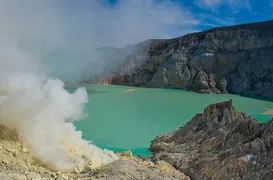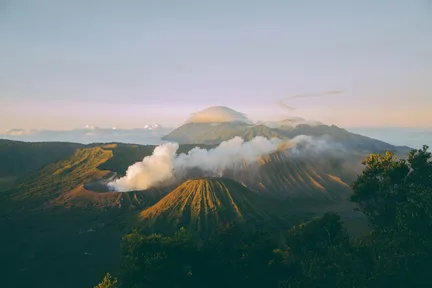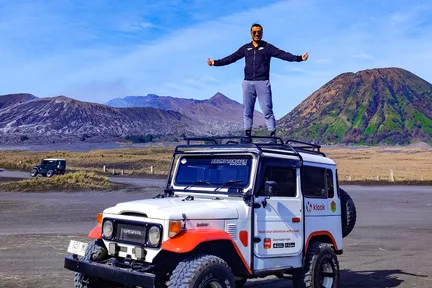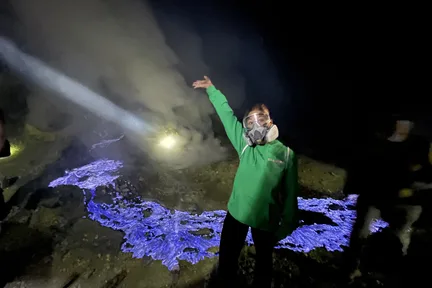Ijen

The best of Ijen
Bucket-list experiences
Make it a getaway
More to explore
Why people love Ijen
Nearby places to go
FAQs about Ijen
When is the best time to visit Kawah Ijen?
How can I get to Kawah Ijen from Banyuwangi or Surabaya?
What safety precautions should I take when visiting Kawah Ijen?
What should I bring for the hike to Kawah Ijen?
How should I interact with the miners at Kawah Ijen?
What to know before visiting Ijen
Remarkable Landmarks and Must-Visit Sights
Blue Fire
Prepare to be mesmerized by the enchanting Blue Fire of Kawah Ijen, a rare natural phenomenon that draws adventurers from around the globe. As the clock strikes midnight, the darkness is pierced by ethereal blue flames, a result of ignited sulfuric gas escaping from the earth's crust. These flames can soar up to five meters high, creating a surreal and unforgettable spectacle. Join a midnight hiking tour to witness this otherworldly wonder and experience the magic of nature's light show.
Acidic Crater Lake
Discover the breathtaking beauty of Kawah Ijen's Acidic Crater Lake, the largest of its kind in the world. This striking turquoise lake, nestled within the volcanic crater, owes its vibrant hue to the high concentration of sulfuric acid. A hike to the crater's rim offers panoramic views of this unique geological marvel, where the lake's vivid color contrasts dramatically with the surrounding landscape. It's a sight that promises to leave you in awe of nature's artistry.
Sulfur Mining
Step into the world of Kawah Ijen's Sulfur Mining, where the resilience and strength of human spirit are on full display. Here, miners brave the harsh conditions to extract sulfur from the crater floor, carrying heavy loads up steep paths to the crater rim and beyond. This labor-intensive process offers a poignant glimpse into the lives of those who work tirelessly amidst the volcano's rugged beauty. Witnessing their daily toil is both humbling and inspiring, providing a deeper appreciation for the human capacity to endure.
Geological Significance
Kawah Ijen is a fascinating part of a larger caldera complex, featuring several post-caldera cones and craters. The active crater itself is impressive, with a diameter of 722 meters and a depth of 200 meters. As part of the Ijen Geopark, which was recognized as a UNESCO Global Geopark in 2023, this area offers a unique glimpse into the Earth's geological wonders.
Cultural Practices
The local community's reference to the mesmerizing blue fire as 'Api Biru' is just one aspect of the rich cultural tapestry surrounding Kawah Ijen. The tradition of sulfur mining, passed down through generations, is a testament to the region's cultural heritage and the resilience of its people.
Cultural and Historical Significance
Kawah Ijen is steeped in cultural and historical significance. The enduring tradition of sulfur mining, coupled with local folklore and legends, enriches the experience of visiting this natural wonder. Its unique geological and chemical properties have also made it a site of scientific interest over the years.
Local Cuisine
While exploring Kawah Ijen, treat your taste buds to local culinary delights such as 'Nasi Tempong,' a spicy rice dish, and 'Rujak Soto,' a unique blend of fruit salad and beef soup. For a true taste of East Java, don't miss out on 'nasi goreng' (fried rice) and refreshing fresh coconuts spritzed with lime.
Cultural Significance
Kawah Ijen holds immense cultural importance for the local communities, particularly those involved in sulfur mining. The miners' resilience and dedication are a powerful reminder of the intersection between natural beauty and human endurance.
Historical Context
The history of sulfur mining at Kawah Ijen dates back to colonial times, adding a rich historical layer to the experience of visiting this remarkable volcano. This backdrop provides a deeper understanding of the area's significance and the enduring legacy of its mining activities.
Explore more on Klook
Top destinations in Indonesia
- 1 Jakarta
- 2 Batam
- 3 Bintan
- 4 Labuan Bajo
- 5 Yogyakarta
- 6 Surabaya
- 7 Malang
- 8 Bandung
- 9 Bali
- 10 Bogor
- 11 Banyuwangi
- 12 Medan



